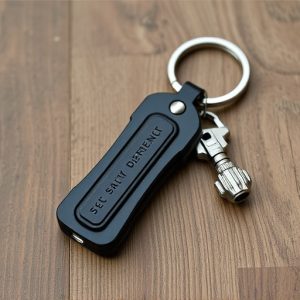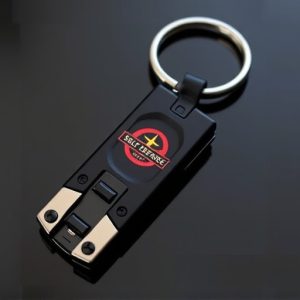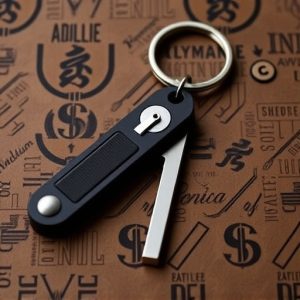Keychain Safety Devices: Legal Requirements & Self-Defense Accessory Compliance
Before purchasing a stylish self-defense keychain accessory, it's vital to understand local law…….
Before purchasing a stylish self-defense keychain accessory, it's vital to understand local laws and regulations, as they vary globally. These legal frameworks define what constitutes a legal self-defense keychain based on design, functionality, and potential impact. Consumers and manufacturers must ensure compliance by checking certifications, third-party testing, industry standards, and regulatory bodies' backing. Manufacturers should also adhere to safety standards, conduct thorough testing, provide clear instructions, and offer detailed information about limitations and usage to avoid legal complications and foster safe use of these accessories.
Staying safe on the go has never been more stylish with the rise of self-defense keychain accessories. But navigating legal requirements can be a confusing labyrinth. This comprehensive guide dives into the intricate world of keychain safety devices, exploring regional variations in legislation and highlighting key features that ensure compliance. From understanding the legal frameworks to practical tips for consumers and manufacturers, discover how to choose and create the ultimate legally sound self-defense keychain accessory.
- Understanding Legal Frameworks for Self-Defense Keychain Devices
- Key Features and Components of a Legal Keychain Safety Device
- Regional Variations in Legislation: An Overview
- Ensuring Compliance: Tips for Consumers and Manufacturers
Understanding Legal Frameworks for Self-Defense Keychain Devices
When considering a stylish self-defense keychain accessory, it’s crucial to navigate the legal frameworks that govern such devices. Different regions have varying laws and regulations regarding personal defense tools, including keychains designed for safety. Understanding these legal requirements is essential before investing in such an accessory, as it ensures you remain compliant and fully aware of your rights and responsibilities.
Each country or state may define what constitutes a legal self-defense keychain, considering factors like the device’s design, functionality, and potential impact. Some jurisdictions might allow only certain types of non-lethal weapons, while others have stricter restrictions. Therefore, researching and verifying local laws is a vital step before purchasing any self-defense keychain accessory to avoid any legal complications.
Key Features and Components of a Legal Keychain Safety Device
A legal keychain safety device is more than just a stylish self-defense accessory; it’s designed with critical components to ensure effectiveness and compliance. These devices often incorporate a sharp edge or spike that can deter potential attackers, allowing users to defend themselves in various situations. The key features include a robust construction for durability, a reliable locking mechanism to secure the device when not in use, and a compact design that fits comfortably on a keychain.
Some advanced models may also have added functionalities like LED lights for improved visibility during emergencies, or even GPS tracking capabilities to help law enforcement locate the user if needed. The components should be carefully chosen to meet legal standards, ensuring that the device is not only effective but also does not violate any local regulations regarding self-defense tools. This balance between style and safety makes these keychains a practical choice for individuals seeking both fashion and personal security.
Regional Variations in Legislation: An Overview
The legal landscape surrounding keychain safety devices can vary significantly from one region to another, reflecting diverse cultural perspectives and societal needs. While some areas might have stringent regulations on self-defense tools, others may take a more lenient approach. This variability is particularly relevant when it comes to stylish self-defense keychain accessories, as designers and manufacturers must stay informed about local laws to ensure their products remain legal and accessible.
For instance, certain jurisdictions require that any device capable of causing harm be registered or licensed, whereas other regions might ban specific types of keychains altogether based on their perceived potential for injury. Understanding these regional variations is crucial for both consumers looking to purchase such accessories and businesses aiming to distribute them. This knowledge ensures compliance with local laws, fosters a safe environment, and promotes the responsible use of stylish self-defense keychain accessories.
Ensuring Compliance: Tips for Consumers and Manufacturers
Ensuring compliance with legal requirements is paramount for both consumers and manufacturers in the market for stylish self-defense keychain accessories. Consumers should be vigilant, checking for certifications and third-party testing that guarantee the device’s effectiveness and safety. Look out for products backed by industry standards or regulatory bodies, ensuring they meet minimum performance criteria.
Manufacturers, on their part, have a legal obligation to produce safe goods. This involves adhering to relevant safety standards, conducting thorough product testing, and providing clear instructions and warnings. Offering detailed information about the device’s limitations and proper usage can better protect consumers and avoid potential legal issues. Regularly reviewing and updating safety protocols is essential to keep up with evolving regulations in this dynamic market.
When considering the acquisition of a keychain safety device, it’s crucial to navigate the legal frameworks that govern self-defense accessories in your region. By understanding the key features and components that constitute a legal device, and being aware of regional variations in legislation, consumers can make informed choices while manufacturers can ensure their products meet necessary standards. Remember, staying compliant with these requirements is not just about avoiding legal repercussions; it’s about empowering yourself with stylish self-defense keychain accessories that provide peace of mind.


